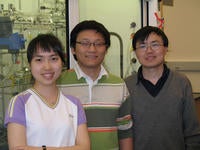RIVERSIDE, Calif. — University of California, Riverside nanotechnologists have succeeded in controlling the color of very small particles of iron oxide suspended in water simply by applying an external magnetic field to the solution. The discovery has potential to greatly improve the quality and size of electronic display screens and to enable the manufacture of products such as erasable and rewritable electronic paper and ink that can change color electromagnetically.
In their experiments, the researchers found that by changing the strength of the magnetic field they were able to change the color of the iron oxide solution — similar to adjusting the color of a television screen image.
When the strength of the magnetic field is changed, it alters the arrangement of the spherical iron oxide particles in solution, thereby modifying how light falling on the particles passes through or is deflected by the solution.
Study results appear in Angewandte Chemie International Edition’s online edition today. The research paper is scheduled to appear in print in issue 34 of the journal. Identified by Angewandte Chemie as a “very important paper,” the research will be featured on the inside cover of the print issue.
“The key is to design the structure of iron oxide nanoparticles through chemical synthesis so that these nanoparticles self-assemble into three-dimensionally ordered colloidal crystals in a magnetic field,” said Yadong Yin, an assistant professor of chemistry who led the research.
A nanoparticle is a microscopic particle whose size is measured in nanometers, a nanometer being a billionth of a meter. (A pin head is 1 million nanometers wide.)
A colloid is a substance comprised of small particles uniformly distributed in another substance. Milk, paint and blood are examples of colloids.
“By reflecting light, these crystals — also called photonic crystals — show brilliant colors,” Yin said. “Ours is the first report of a photonic crystal that is fully tunable in the visible range of the electromagnetic spectrum, from violet light to red light.”
A photonic crystal controls the flow of light (photons) and works like a semiconductor for light. The nanoparticles’ spacing dictates the wavelength of light that a photonic crystal reflects.
Iron oxide (formula: Fe3O4) nanoparticles are “superparamagnetic,” meaning that they turn magnetic only in the presence of an external magnetic field. In contrast, “ferromagnetic” materials become magnetized in a magnetic field and retain their magnetism when the field is removed.
The researchers used the superparamagnetic property of iron oxide particles to tune the spacing between nanoparticles, and therefore the wavelength of the light reflection — or the color of the colloidal crystals — by changing the strength of the external magnetic field.
“Other reported photonic crystals can only reflect light with a fixed wavelength,” Yin said. “Our crystals, on the other hand, show a rapid, wide and fully reversible optical response to the external magnetic field.”
Photonic materials such as those used by Yin and his team could help in the fabrication of new optical microelectromechanical systems and reflective color display units. They also have applications in telecommunication (fiber optics), sensors and lasers.
“This is an elegant method that allows researchers in the field to assemble photonic crystals and control their spacing by using a magnetic field,” said Orlin Velev, an associate professor of chemical and biomolecular engineering at North Carolina State University, Raleigh, N.C., who was not involved in the research. “A simple magnet can be used to change the color of a suspension throughout the whole visible spectra. This has potential to result in usable precursors for various photonic devices.”
“What should make the technology commercially attractive is that iron oxide is cheap, non-toxic and available in plenty,” Yin said.
Yin explained that the new technology can be used to make an inexpensive color display by forming millions of small pixels using the photonic crystals. “A different color for each pixel can be assigned using a magnetic field,” he said. “The advantage is that you need just one material — for example, photonic crystals like iron oxide — for all the pixels. Moreover, you don’t need to generate light in each pixel. You would be using reflected light to create the images — a form of recycling.”
Yin was joined in the research by UC Riverside’s Jianping Ge, a postdoctoral researcher, and Yongxing Hu, a first-year graduate student in the Department of Chemistry.
The UCR Office of Technology Commercialization has filed a patent application on the technology.
